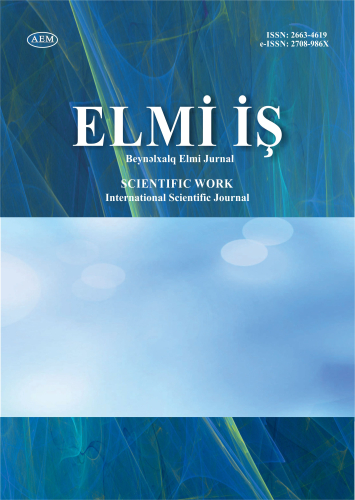Arxiv
ELM─░ ─░┼ъ - 2025
л»ЛђлЙЛЂл╗л░л▓ лњл░л╗лхлйЛѓлИлйлЙл▓лИЛЄ лЪлИл╗лИл┐ЛЄЛЃл║
лЮл░ЛєлИлЙлйл░л╗ЛїлйЛІл╣ л┐лхл┤л░л│лЙл│лИЛЄлхЛЂл║лИл╣ ЛЃлйлИл▓лхЛђЛЂлИЛѓлхЛѓ лИл╝. лю.лЪ.лћЛђл░л│лЙл╝л░лйлЙл▓л░
pylypchuk.yaroslav@gmail.com
люлБлАлБлЏлглюлљлЮлАлџлљл» лЊлълАлБлћлљлалАлблњлЋлЮлЮлълАлблг лњ лљлЌлЋлалЉлљлЎлћлќлљлЮлЋ (IX-XIII┬алњлњ.)
лалхлиЛјл╝лх
лЪЛђлЙл▓лхл┤ЛЈ лИЛЂЛЂл╗лхл┤лЙл▓л░лйлИлх л╝ЛІ л┐ЛђлИЛѕл╗лИ л║ ЛЂл╗лхл┤ЛЃЛјЛЅлИл╝ л▓ЛІл▓лЙл┤л░л╝. лЪлхЛђл▓лЙл╣ л┐лЙ лйл░ЛЂЛѓлЙЛЈЛЅлхл╝ЛЃ ЛЂлИл╗ЛїлйлЙл╣ л▒ЛІл╗л░ л┤лИлйл░ЛЂЛѓлИЛЈ лАл░л┤лХлИл┤лЙл▓, л┐ЛђлЙлИЛЂЛЁлЙл┤ЛЈЛЅл░ЛЈ лИли ЛЂлЙл│л┤лИл╣ЛЂл║лЙл╣ л░ЛђлИЛЂЛѓлЙл║Лђл░ЛѓлИлИ. лЋлх л┐Лђлхл┤ЛЂЛѓл░л▓лИЛѓлхл╗лИ л▓лЙлил▓ЛІЛЂлИл╗лИЛЂЛї л║л░л║ л│ЛЃл╗ЛЈл╝ЛІ лйл░ ЛЂл╗ЛЃлХл▒лх ЛЃ лљл▒л▒л░ЛЂлИл┤лЙл▓. лАЛѓл░л▓ л┐Лђл░л▓лИЛѓлхл╗ЛЈл╝лИ л▓ лљлилхЛђл▒л░л╣л┤лХл░лйлх, лАл░л┤лХлИл┤ЛІ ЛЂЛѓл░Лђл░л╗лИЛЂЛї л┐ЛђлЙл▓лЙл┤лИЛѓЛї ЛЂл░л╝лЙЛЂЛѓлЙЛЈЛѓлхл╗ЛїлйЛЃЛј лИ л░л│ЛђлхЛЂЛЂлИл▓лйЛЃЛј л┐лЙл╗лИЛѓлИл║ЛЃ л▓ лЙЛѓлйлЙЛѕлхлйлИлИ лљЛђл╝лхлйлИлИ, ЛЄЛѓлЙ лйлх л▓ЛЂлхл│л┤л░ л▓ЛІлиЛІл▓л░л╗лЙ л┐лЙлилИЛѓлИл▓лйЛЃЛј Лђлхл░л║ЛєлИЛј ЛЂлЙ ЛЂЛѓлЙЛђлЙлйЛЃ ЛЁл░л╗лИЛёл░. лЏлИЛѕЛї л▓ л║лЙлйЛєлх л┐Лђл░л▓л╗лхлйлИЛЈ лАл░л┤лХлИл┤лЙл▓ лИЛЁ лИлйЛѓлхЛђлхЛЂЛІ лйл░ЛЄл░л╗лИ ЛЂлйлЙл▓л░ ЛЂлЙл▓л┐л░л┤л░ЛѓЛї ЛЂ лИлйЛѓлхЛђлхЛЂл░л╝лИ лЉл░л│л┤л░л┤л░. люЛЃлил░Лёл░ЛђлИл┤ЛІ л▒ЛІл╗лИ лхЛЅлх лЙл┤лйлЙл╣ лИЛђл░лйЛЂл║лЙл╣ л┤лИлйл░ЛЂЛѓлИлхл╣, лйл░ ЛЇЛѓлЙЛѓ Лђл░ли л┤лхл╣л╗лхл╝лИЛѓЛЂл║лЙл╣. лЋлх л┐Лђлхл┤ЛЂЛѓл░л▓лИЛѓлхл╗лИ л┐ЛђлЙлйлИл║л╗лИ лИли лћлхл╣л╗лхл╝л░ л▓ ЛЁлЙл┤лх ЛЂл▓лЙлхл╣ ЛЇл║ЛЂл┐л░лйЛЂлИлИ лйл░ ЛЂлхл▓лхЛђлЙ-лил░л┐л░л┤. лълйлИ л┐ЛђлИлйЛЈл╗лИ лйл░ ЛЂлхл▒ЛЈ ЛЃл┤л░ЛђЛІ ЛЂлЙ ЛЂЛѓлЙЛђлЙлйЛІ лаЛЃЛЂлИ, лал░л▓л▓л░л┤лИл┤лЙл▓ лИ лАлхл╗Лїл┤лХЛЃл║лЙл▓. лал░л▓л▓л░л┤лИл┤ЛІ л▒ЛІл╗лИ л┤лИлйл░ЛЂЛѓлИлхл╣ л░Лђл░л▒ЛЂл║лЙл│лЙ л┐ЛђлЙлИЛЂЛЁлЙлХл┤лхлйлИЛЈ, л║лЙЛѓлЙЛђл░ЛЈ л▓ЛЂл║лЙЛђлх л║ЛЃЛђл┤лИлилИЛђлЙл▓л░л╗л░ЛЂЛї. лълйлЙл╝л░ЛЂЛѓлИл║лЙлй л┤лИлйл░ЛЂЛѓлИлИ л▓┬аX┬аРђЊ┬аXI┬ал▓л▓. л▓ Лєлхл╗лЙл╝ лИЛђл░лйЛЂл║лИл╣. лГл┐лЙЛЁлЙл╣ лйл░лИл▒лЙл╗ЛїЛѕлхл│лЙ л╝лЙл│ЛЃЛЅлхЛЂЛѓл▓л░ лал░л▓л▓л░л┤лИл┤лЙл▓ л▒ЛІл╗лЙ л▓Лђлхл╝ЛЈ л┐Лђл░л▓л╗лхлйлИЛЈ люл░л╝л╗л░лйл░┬аI, л║лЙЛѓлЙЛђЛІл╣ л┐ЛђлЙл▓лЙл┤лИл╗ л░л│ЛђлхЛЂЛЂлИл▓лйЛЃЛј л┐лЙл╗лИЛѓлИл║ЛЃ л┐лЙ лЙЛѓлйлЙЛѕлхлйлИЛј л║ ЛЁЛђлИЛЂЛѓлИл░лйЛЂл║лИл╝ ЛЂлЙЛЂлхл┤ЛЈл╝ лИ ЛЃл│ЛђлЙлиЛЃ ЛЂлЙ ЛЂЛѓлЙЛђлЙлйЛЃ л║лЙЛѓлЙЛђлЙл│лЙ л░Лђл╝ЛЈлйлх лИ л│ЛђЛЃлилИлйЛІ лйлхл╣ЛѓЛђл░л╗лИлилЙл▓л░л╗лИ л┐ЛЃЛѓлхл╝ лил░л║л╗ЛјЛЄлхлйлИЛЈ лЙл▒лЙЛђлЙлйлИЛѓлхл╗ЛїлйлЙл│лЙ ЛЂлЙЛјлил░.┬алЦлє┬ал▓. л▒ЛІл╗ л▓Лђлхл╝лхлйлхл╝ л┐лЙЛЂЛѓлхл┐лхлйлйлЙл│лЙ ЛЃл│л░ЛЂл░лйлИЛЈ лал░л▓л▓л░л┤лИл┤лЙл▓. лелхл┤л┤л░л┤лИл┤ЛІ л▒ЛІл╗лИ л┐лЙ л┐ЛђлЙлИЛЂЛЁлЙлХл┤лхлйлИЛј л║ЛЃЛђл┤ЛЂл║лЙл╣ л┤лИлйл░ЛЂЛѓлИлхл╣ лИ л┐Лђл░л▓лИл╗лИ л▓ лљЛђЛђл░лйлх. люлхл┤л╗лхлйлйЛІл╣ ЛђлЙЛЂЛѓ лИЛЁ л▓л╗л░ЛЂЛѓлИ лйл░л▒л╗Лјл┤л░л╗ЛЂЛЈ л▓ лЦ л▓., л║лЙл│л┤л░ лЙлйлИ лйл░ЛЄл░л╗лИ ЛЇл║ЛЂл┐л░лйЛЂлИЛј л▓лЙ л▓л╗л░л┤лхлйлИЛЈ люЛЃлил░Лёл░ЛђлИл┤лЙл▓. лћл╗ЛЈ ЛЇЛѓлЙл╣ л┤лИлйл░ЛЂЛѓлИлИ ЛЁл░Лђл░л║ЛѓлхЛђлйЛІ ЛѓлхЛЂлйЛІлх ЛЂл▓ЛЈлилИ ЛЂ л░Лђл╝ЛЈлйл░л╝лИ. лГл╝лИЛђЛІ лцл░л┤л╗ лИ лљл▒ЛЃ-л╗-лљЛЂл▓л░Лђ лЙЛЂЛЃЛЅлхЛЂЛѓл▓л╗ЛЈл╗лИ лйл░ЛѓлИЛЂл║ лйл░ л░Лђл╝ЛЈлйЛЂл║лИлх ЛѓлхЛђЛђлИЛѓлЙЛђлИлИ, л║лЙЛѓлЙЛђЛІлх л░Лђл╝ЛЈлйлх ЛЂл╝лЙл│л╗лИ лЙЛѓл▒лИЛѓЛї ЛѓлЙл╗Лїл║лЙ л║лЙлЙл┐лхЛђлИЛђЛЃЛЈЛЂЛї ЛЂ л│ЛђЛЃлилИлйл░л╝лИ. лБлйлИЛЄЛѓлЙлХлИЛѓЛї ЛЇл╝лИЛђл░Лѓ лелхл┤л┤л░л┤лИл┤лЙл▓ лйлх л▒ЛІл╗лИ ЛЂл┐лЙЛЂлЙл▒лйЛІ лИ ЛђлЙл╝лхлИ л▓ ЛЂлхЛђлхл┤лИлйлх┬аXI┬ал▓. лњл╗л░ЛЂЛѓЛї лелхл┤л┤л░л┤лИл┤лЙл▓ л▓ лљЛђЛђл░лйлх ЛЂл╝лЙл│л╗лИ л╗лИл║л▓лИл┤лИЛђлЙл▓л░ЛѓЛї ЛѓлЙл╗Лїл║лЙ лАлхл╗Лїл┤лХЛЃл║лИ л▓ 1093 л│., л░ л▓ лелИЛђл░л║лх лЙлйлИ л┐ЛђлЙл┤лхЛђлХл░л╗лИЛЂЛї л┤лЙ 1199 л│. лелИЛђл▓л░лй л▒ЛІл╗лЙ л│лЙЛЂЛЃл┤л░ЛђЛЂЛѓл▓лЙл╝ лйл░ЛЂлхл╗лхлйЛІл╝ лИЛђл░лйлЙЛЈлиЛІЛЄлйЛІл╝ лИ л║л░л▓л║л░лилЙЛЈЛЄлйЛІл╝ лйл░ЛЂлхл╗лхлйлИлхл╝. лћлИлйл░ЛЂЛѓлИЛЈ люл░лил╣л░л┤лИл┤лЙл▓ л┐лхЛђл▓лЙлйл░ЛЄл░л╗ЛїлйлЙ л▒ЛІл╗лЙ л░Лђл░л▒ЛЂл║лЙл╣ л┐лЙ л┐ЛђлЙлИЛЂЛЁлЙлХл┤лхлйлИЛј. лелИЛђл▓л░лй л┐лЙл┤л┤лхЛђлХлИл▓л░л╗ ЛѓлхЛЂлйЛІлх ЛЂл▓ЛЈлилИ ЛЂ л│лЙЛЂЛЃл┤л░ЛђЛЂЛѓл▓лЙл╝ лЏл░л╣лил░лй. лњ лЦ л▓лхл║лх ЛѕлИЛђл▓л░лйЛѕл░ЛЁлИ Лђл░ЛЂл┐ЛђлЙЛЂЛѓЛђл░лйЛЈл╗лИ л▓л╗л░ЛЂЛѓЛї л║ЛђлЙл╝лх лелИЛђл▓л░лйл░ лхЛЅлх лйл░ лћлхЛђл▒лхлйЛѓ лИ лљЛђЛђл░лй.┬алњлЙ л▓ЛѓлЙЛђлЙл╣ ЛЄлхЛѓл▓лхЛђЛѓлИ┬аXI┬ал▓. люл░лил╣л░л┤лИл┤лЙл▓ ЛЂл╝лхлйлИл╗л░ л┤лИлйл░ЛЂЛѓлИЛЈ лџлхЛЂЛђл░лйлИл┤лЙл▓, лЙлйлЙл╝л░ЛЂЛѓлИл║лЙлй л║лЙЛѓлЙЛђлЙл╣ ЛЃлХлх лИЛђл░лйЛЂл║лИл╣. лГЛѓлЙ л┤лИлйл░ЛЂЛѓлИЛЈ л▓ лЙЛѓл╗лИЛЄлИлИ лЙЛѓ лелхл┤л┤л░л┤лИл┤лЙл▓ л▓ лљЛђЛђл░лйлх лИ лал░л▓л▓л░л┤лИл┤лЙл▓ л▓ лљлилхЛђл▒л░л╣л┤лХл░лйлх ЛЃл┤лхЛђлХл░л╗л░ л▓л╗л░ЛЂЛѓЛї л▓ лелИЛђл▓л░лйлх л┐ЛђлИ лАлхл╗Лїл┤лХЛЃл║л░ЛЁ. лџлхЛЂЛђл░лйлИл┤ЛІ, л║л░л║ лИ люл░лил╣л░л┤лИл┤ЛІ, л┐ЛђлЙл┤лЙл╗лХл░л╗лИ л┐ЛђлхЛѓлхлйл┤лЙл▓л░ЛѓЛї лйл░ л▓л╗л░ЛЂЛѓЛї лйл░л┤ лћлхЛђл▒лхлйЛѓлЙл▓. лњ┬аXII┬ал▓. лелИЛђл▓л░лй ЛЂЛѓл░л╗ лЙл▒Лілхл║ЛѓлЙл╝ ЛЇл║ЛЂл┐л░лйЛЂлИлИ ЛЂлЙ ЛЂЛѓлЙЛђлЙлйЛІ лЊЛђЛЃлилИлИ. лАлЙл┐ЛђлЙЛѓлИл▓л╗ЛЈЛѓЛїЛЂЛЈ лхл╣ л╝лЙл│л╗лИ ЛѕлИЛђл▓л░лйЛєЛІ ЛѓлЙл╗Лїл║лЙ л┐ЛђлИ л┐лЙл╝лЙЛЅлИ лАлхл╗Лїл┤лХЛЃл║лЙл▓. лъл┤лйл░л║лЙ ЛЇЛѓлЙ лйлх лИЛЂл║л╗ЛјЛЄл░л╗лЙ л┤лИлйл░ЛЂЛѓлИЛЄлхЛЂл║лИЛЁ л▒Лђл░л║лЙл▓ ЛЂ л│ЛђЛЃлилИлйЛЂл║лИл╝лИ лЉл░л│Лђл░ЛѓлИлЙлйлИ. лАл░л╝ЛІл╝ л▓ЛІл┤л░ЛјЛЅлИл╝ЛЂЛЈ лџлхЛЂЛђл░лйлИл┤лЙл╝ л▒ЛІл╗ ЛѕлИЛђл▓л░лйЛѕл░ЛЁ лљЛЁЛЂлИЛѓл░лй, л║лЙЛѓлЙЛђЛІл╣ л┐ЛђлИ л┐лЙл╝лЙЛЅлИ л│ЛђЛЃлилИлй лЙЛѓЛђл░лилИл╗ л▓ЛѓлЙЛђлХлхлйлИлх л┤лхЛђл▒лхлйЛѓЛЂл║лИЛЁ ЛЁл░лил░Лђ лИ л╗лИЛЄлйлЙ лЙЛѓЛђл░лилИл╗ л▓ЛѓлЙЛђлХлхлйлИлх л┤л░л│лхЛЂЛѓл░лйЛЂл║лИЛЁ л│лЙЛђЛєлхл▓. лњ ЛЂлЙЛјлилх ЛЂ Лєл░ЛђлИЛєлхл╣ лбл░л╝л░Лђ ЛѕлИЛђл▓л░лйЛѕл░ЛЁ л┐ЛђлЙЛѓлИл▓лЙЛЂЛѓлЙЛЈл╗ л░Лѓл░л▒лхл║л░л╝ лљлилхЛђл▒л░л╣л┤лХл░лйл░.┬аXIII┬ал▓. л▒ЛІл╗ л▓Лђлхл╝лхлйлхл╝ ЛЃл┐л░л┤л║л░ лелИЛђл▓л░лйл░, л║лЙл│л┤л░ лЙлй ЛЂЛѓл░л▓л░л╗ лЙл▒Лілхл║ЛѓлЙл╝ л▓ЛѓлЙЛђлХлхлйлИл╣ л╝лЙлйл│лЙл╗лЙл▓, л║ЛІл┐ЛЄл░л║лЙл▓ лИ ЛЁлЙЛђлхлил╝лИл╣Лєлхл▓. лА 1070 л│. лљлилхЛђл▒л░л╣л┤лХл░лй ЛЂЛѓл░л╗ л▓л╗л░л┤лхлйлИлхл╝ лАлхл╗Лїл┤лХЛЃл║лИл┤лЙл▓, л░ ЛЂ 1093 л│. Лѓл░л║лИл╝ ЛЂЛѓл░л╗┬алљЛђЛђл░лй. лЮл░ л┐ЛђлЙЛѓЛЈлХлхлйлИлИ лйлхЛЂл║лЙл╗Лїл║лИЛЁ л┤лхЛЂЛЈЛѓлИл╗лхЛѓлИл╣ лљлилхЛђл▒л░л╣л┤лХл░лй лИ лљЛђЛђл░лй л▒ЛІл╗лИ л▓л╗л░л┤лхлйлИлхл╝ л╝л╗л░л┤ЛѕлИЛЁ лАлхл╗Лїл┤лХЛЃл║лИл┤лЙл▓ лИ л▓ЛЁлЙл┤лИл╗лИ л▓ ЛЂлЙЛЂЛѓл░л▓ лўЛђл░л║ЛЂл║лЙл│лЙ ЛЂЛЃл╗Лѓл░лйл░Лѓл░ лАлхл╗Лїл┤лХЛЃл║лЙл▓. лъЛёлЙЛђл╝л╗лхлйлИлх л│лЙЛЂЛЃл┤л░ЛђЛЂЛѓл▓л░ л░Лѓл░л▒лхл║лЙл▓ лљлилхЛђл▒л░л╣л┤лХл░лйл░ л╝лЙлХлйлЙ л┤л░ЛѓлИЛђлЙл▓л░ЛѓЛї ЛЂлхЛђлхл┤лИлйлЙл╣┬аXII┬ал▓. лЪЛђлИ лхл│лЙ л┐лхЛђл▓ЛІЛЁ л┐Лђл░л▓лИЛѓлхл╗ЛЈЛЁ лел░л╝ЛЂ л░л┤-лћлИлйлх лўл╗Лїл┤лхлйл│лИлилх лИ лћлХл░ЛЁл░лй-лЪлхЛЁлхл╗лхл▓л░лйлх л▓л╗лИЛЈлйлИлх лўл╗Лїл┤лхлйл│лИлилИл┤лЙл▓ л┐ЛђлЙЛЂЛѓлИЛђл░л╗л░ЛЂЛї лЙЛѓ лџл░ЛЂл┐лИл╣ЛЂл║лЙл│лЙ л╝лЙЛђЛЈ л┤лЙ лЪлхЛђЛЂлИл┤ЛЂл║лЙл│лЙ лил░л╗лИл▓л░ лИ лЙЛѓ лГЛђлилхЛђЛЃл╝л░ л┤лЙ лЦлЙЛђл░ЛЂл░лйл░. лўл╗Лїл┤лхлйл│лИлилИл┤ЛІ л▒ЛІл╗лИ Лѓлхл╝лИ, л║ЛѓлЙ ЛЂл┤лхЛђлХлИл▓л░л╗ ЛЇл║ЛЂл┐л░лйЛЂлИЛј л│ЛђЛЃлилИлйЛЂл║лИЛЁ лЉл░л│Лђл░ЛѓлИлЙлйлИ л┐ЛђлЙЛѓлИл▓ л╝ЛЃЛЂЛЃл╗Лїл╝л░лйЛЂл║лИЛЁ ЛЂЛѓЛђл░лй лИ Лёл░л║ЛѓлИЛЄлхЛЂл║лИ л▒ЛІл╗лИ л▓ЛЂлхЛЂлИл╗ЛїлйЛІл╝лИ л┤лхл╗л░Лѓлхл╗ЛЈл╝лИ ЛЂЛЃл╗Лѓл░лйлЙл▓ л┐ЛђлИ ЛЂл╗л░л▒ЛІЛЁ лАлхл╗Лїл┤лХЛЃл║лИл┤л░ЛЁ. лџЛІлиЛІл╗-лљЛђЛЂл╗л░лй ЛЃлХлх л┐лхЛђлхЛЂЛѓл░л╗ ЛЂлЙл▓ЛЂлхл╝ лЙЛЂл╝л░ЛѓЛђлИл▓л░ЛѓЛїЛЂЛЈ лйл░ лАлхл╗Лїл┤лХЛЃл║лИл┤лЙл▓ лИ ЛѓлИЛѓЛЃл╗лИЛђлЙл▓л░л╗ ЛЂлхл▒ЛЈ л┐ЛІЛѕлйЛІл╝ ЛѓлИЛѓЛЃл╗лЙл╝. лџлЙлйлхЛє┬аXII┬ал▓. - лйл░ЛЄл░л╗лЙ┬аXIII┬ал▓. л▒ЛІл╗лИ л▓Лђлхл╝лхлйлхл╝ ЛЃл┐л░л┤л║л░ л░Лѓл░л▒лхл║лЙл▓ лљлилхЛђл▒л░л╣л┤лХл░лйл░ лИли-лил░ ЛЃЛЂлЙл▒лИЛє л╝лхлХл┤ЛЃ лўл╗Лїл┤лхлйл│лИлилИл┤л░л╝лИ лИ л┐лЙл▒лхл┤ л│ЛђЛЃлилИлй. 20-30-лх л│л│.┬аXIII┬ал▓. л▒ЛІл╗лИ л▓Лђлхл╝лхлйлхл╝ л┐л░л┤лхлйлИЛЈ л│лЙЛЂЛЃл┤л░ЛђЛЂЛѓл▓л░ л░Лѓл░л▒лхл║лЙл▓ лљлилхЛђл▒л░л╣л┤лХл░лйл░.
лџл╗ЛјЛЄлхл▓ЛІлх ЛЂл╗лЙл▓л░:┬алелИЛђл▓л░лй, лљлилхЛђл▒л░л╣л┤лХл░лй, лљЛђЛђл░лй, лАл░л┤лХлИл┤ЛІ, люлЙЛЂл░ЛёлхЛђлИл┤ЛІ, лелхл┤л┤л░л┤лИл┤ЛІ, лал░л▓л▓л░л┤лИл┤ЛІ, лўл╗Лїл┤лхлйл│лИлилИл┤ЛІ, лАлхл╗Лїл┤лХЛЃл║лИ.┬а
Muslim statehood in Azerbaycan (IX-XIII centuries)
Summary
This paper is dedicated to the history of Muslim statehood in Azerbaijan in IX-XIII century. The first truly strong was the Sajid dynasty, originating from the Sogdian aristocracy. Its representatives exalted themselves as ghouls in the service of the Abbasids. Having become rulers in Azerbaijan, the Sajids tried to pursue an independent and aggressive policy towards Armenia, which did not always provoke a positive reaction from the caliph. Only at the end of the Sajid rule did their interests again coincide with those of Baghdad. The Muzafarids were another Iranian dynasty, this time the Delemite. Its representatives came from Dalem during its expansion to the northwest. They took upon themselves the blows from Russia, the Ravadids and the Seljuks. The rabadids were a dynasty of Arab origin, which soon became Kurdish. Onomasticon of the dynasty in the 10th - 11th centuries generally Iranian. The era of the greatest power of the Rawwadids was the time of the reign of Mamlan I, who pursued an aggressive policy towards Christian neighbors and the threat from which the Armenians and Georgians neutralized by the conclusion of a defensive alliance. XI century was the time of the gradual fading of the Rawwadids. The Shaddadids were of Kurdish dynasty descent and ruled in Arran. Slow growth of their power was observed in the 10th century, when they began expansion in the possession of the Muzafarids. This dynasty is characterized by close ties with the Armenians. Emirs Fadl and Abu l-Asvar carried out an attack on the Armenian territories, which the Armenians could recapture only by cooperating with the Georgians. To destroy the emirate of the Shaddadids were not able and the Romaios in the middle of the XI century. Only the Seljuks in Arran were able to eliminate the power of the Shaddadids in 1093, and they survived in Shirak until 1199. Shirvan was a state inhabited by Iranian-speaking and Caucasian populations. The Mazyadid dynasty was originally Arab in origin. Shirvan maintained close ties with the state of Lizan. In the tenth century, the Shirvanshahs extended power besides Shirvan to Derbent and Arran. In the second quarter of the XI century. Mazyadids were replaced by the Qesranid dynasty, the onomasticon of which is already Iranian. This dynasty, unlike the Sheddadids in Arran and the Rawwadids in Azerbaijan, retained power in Shirvan under the Seljuks. The Caesranids, like the Mazyadids, continued to claim power over Derbent in the XII century. Shirvan became an object of expansion from Georgia. Shirvans could only resist it with the help of the Seljuks. However, this did not exclude dynastic marriages with Georgian Bagrationi. The most prominent Qesranid was the Shirvanshah Akhsitan, who, with the help of the Georgians, repelled the invasion of the Derbent Khazars and personally repelled the invasion of the Dagestan highlanders. In alliance with Queen Tamar, the Shirvanshah opposed the Atabeks of Azerbaijan. XIII century was the time of the decline of Shirvan, when he became the object of invasion of the Mongols, Kipchaks and Khorezmians. From 1070 Azerbaijan became the possession of the Seljukids, and from 1093 Arran became such. For several decades, Azerbaijan and Arran were the property of the younger Seljukids and were part of the Iraqi Seljuk Sultanate. The design of the state of the Atabeks of Azerbaijan can be dated to the middle of the XII century. Under its first rulers, Shams ad-Din Ildengiz and Jahan-Phelevane, the influence of the Ildengizids extended from the Caspian Sea to the Persian Gulf and from Erzurum to Khorasan. The Ildengizids were those who restrained the expansion of Georgian Bagrationi against Muslim countries and were actually omnipotent workers of the Sultans under the weak Seljukids. Qizil-Arslan has already ceased to look around at the Seljukids completely and has titled itself with a magnificent title. The end of the XII century. - beginning of the XIII century were the time of the decline of the Atabeks of Azerbaijan due to the strife between the Ildengizids and the victories of the Georgians. 20-30-ies of XIII century were the time of the fall of the Atabek state of Azerbaijan.
Key words:┬аShirvan, Azerbaijan, Arran, Sajids, Mosaferids, Shaddadids, Rawwadids, Ildengizids, Seljukids
Bax─▒┼Ъ: 1143

